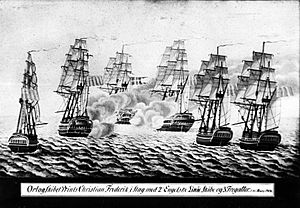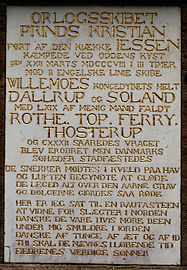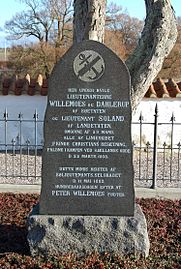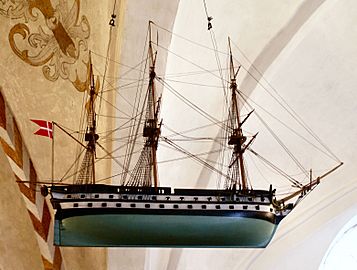Battle of Zealand Point facts for kids
Quick facts for kids Battle of Zealand Point |
|||||||
|---|---|---|---|---|---|---|---|
| Part of the Napoleonic Wars | |||||||
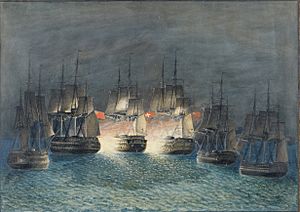 Battle of Zealand Point, A.G. Gross |
|||||||
|
|||||||
| Belligerents | |||||||
| Commanders and leaders | |||||||
| Strength | |||||||
| 3 ships of the line 1 frigate |
1 ship of the line | ||||||
| Casualties and losses | |||||||
| 5 killed 48 wounded 1 missing |
55 killed 88 wounded 1 ship of the line destroyed |
||||||
The Battle of Zealand Point was an important naval battle. It took place on March 22, 1808. This fight was part of the English Wars and the Gunboat War. Danish and British ships battled near Zealand Point. The British navy won this fight. A brave Danish officer named Peter Willemoes was among those who died.
Contents
Why the Battle Happened
Danish Ship's Journey
The Danish warship HDMS Prinds Christian Frederik was in Kristiansand, Norway. From August 1807, it patrolled the waters. These waters were between Norway and Denmark. Britain had blocked these areas.
In February 1808, Prins Christian Frederik chased a British ship. The British ship, HMS Quebec, had to hide. The British navy learned about the Danish ship. They sent a group of their own ships. This group included HMS Nassau, HMS Stately, and HMS Vanguard. Two smaller ships, HMS Constant and HMS Kite, also joined. Their job was to make the waters safe for Britain.
While this was happening, Prins Christian Frederik got stuck in ice. This happened near Kristiansand. So, it could not sail to Denmark until March 4.
Problems for the Danish Crew
When Prins Christian Frederik finally reached Denmark, many sailors were sick. The harbors in Denmark were still frozen. This meant the ship could not dock. New crew members had to come aboard by walking over the ice.
On March 17, the crew's spirits dropped even more. News arrived that King Christian had died. The ship was then ordered to the Great Belt strait. Its mission was to protect a French army crossing. This army included Spanish soldiers. They were ordered by Jean Baptiste Jules Bernadotte to attack Skåne.
British Plan
The British ships found out about the Danish plan. They started to chase Prins Christian Frederik. The British wanted to trap and defeat the Danish ship. Captain Carl Jessen, the Danish commander, talked with his officers. They decided to fight. They hoped to gain an advantage. This would let them move into waters they knew. It would also bring them closer to the cannons at Kronborg for protection.
On March 18, 1808, the crew of HMS Stately worked hard. They cut paths through the sea ice. This allowed Stately and Nassau to sail. The next day, the British squadron was ready. It had three large ships: Nassau, Stately, and Vanguard. It also had the frigate HMS Quebec, two sloops, Falcon and HMS Lynx, and a gunbrig, Constant.
The smaller British ships patrolled the northern areas. They watched the Great Belt and the Øresund. They looked for any strange ships. On March 21, Quebec and Lynx were together. They separated early on March 22. Then Quebec spotted Prins Christian Frederik near Sejerø. Lynx and later HMS Falcon joined Quebec in Sejerø Bay.
The Battle Begins
In the hours before the battle, Prins Christian Frederik was seen by Quebec and Lynx. Around 2 PM, the sloop Falcon joined them. Falcon noted a signal from Quebec: "Danish Line-of-battle-ship to windward." The ships prepared for action.
During the afternoon, the Danish ship changed direction. It sailed north around a reef. This reef was at the west of Sjællands Odde. This is a long piece of land at the northwest of Zealand. The Danish ship was now heading east again, north of the land.
Shortly after 4 PM, Stately and Nassau were seen to the northeast. A signal was sent about the enemy's presence. All the British ships then sailed as fast as they could to chase the Danish ship.
The Fight
The logs from Falcon and Nassau show the battle started at 7:50 PM. Prinds Christian Frederik fired the first shots. It fired its stern cannons at Nassau, which was the closest British ship. By 8:05 PM, Nassau was alongside the Danish ship. It began firing its broadsides.
Forty minutes later, Nassau was in danger of blocking Stately's view. So, Nassau sailed faster and moved out of the way. Then Stately joined the fight. The two British ships took turns attacking. This continued until Prinds Christian Frederik gave up. At this point, the Danish ship was stuck on the ground. It was about 300 meters from the shore.
After the Battle
Throughout the morning of March 23, boats from the British squadron moved prisoners. The ships' crews fixed ropes and rigging. At noon, orders were given to burn Prinds Christian Frederik. This would happen as soon as all the wounded sailors were removed. The fire was set between 7:30 and 8:00 PM. Prinds Christian Frederik exploded shortly before 9:00 PM.
Stately had four men killed. It also had 31 officers and men wounded. Nassau lost one man killed. It had 17 officers and men wounded, and one man missing. Prins Christian Frederik lost 55 men killed. It also had 88 men wounded.
In 1847, the British Admiralty gave out a special medal. It was called the Naval General Service Medal. It had clasps that said "Stately 22 March 1808" and "Nassau 22 March 1808". Any surviving crew members from those ships could claim them.
What Happened Next
End of an Era
The loss of Prins Christian Frederik was very important. It was the last large Danish warship during the Napoleonic Wars.
Remembering the Fallen
Peter Willemoes and the other Danish sailors who died were buried together. Their grave is at Odden churchyard. This is near where the battle happened. Their gravestone can still be seen today.
A monument was also built in the churchyard. It remembers the battle and the Danish sailors. It is a Neoclassical column. It has a plaque with a poem by N.F.S. Grundtvig. The poem is called 'De snekker de mødtes i kvæld på hav'. A special stone was also placed on the beach. It has a crown, an anchor, and an inscription.
Odsherred Museum has a small exhibit about the battle. It shows the anchor, a cannon, and other items. These items came from Prinds Christian Frederik. A model of this ship hangs in Odden Church.
Art About the Battle
Christian Mølsted painted a scene from the battle. It shows Willemoes dying in the arms of his second-in-command, C. A. Rothe. This painting is a bit romanticized. There are two versions of it. One is in Museum Vestfyn (painted in 1901). The other is in the Frederiksborg Museum in Hillerød.
Gallery


